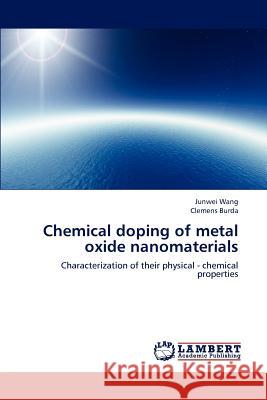Chemical Doping of Metal Oxide Nanomaterials » książka
Chemical Doping of Metal Oxide Nanomaterials
ISBN-13: 9783659183829 / Angielski / Miękka / 2012 / 188 str.
Photocatalysis is considered by many as the most promising solution for energy and environment problems. Among all the photocatalysts available, titanium dioxide remains one of the most studied for decades. Reducing its bandgap via doping is crucial to harvest visible-light, which accounts for 48% of the total solar energy. In addition, it is very important to keep the particle size small to avoid recombination of the photo-generated electrons and holes. In this book, nano-scaled metal and / or non-metal elements have been used as dopants to modify the electronic structure of TiO2. X-ray diffraction patterns (XRD), Raman spectroscopy, UV-Vis diffuse reflectance spectroscopy (UV-DRS), Fourier transform infrared spectroscopy (FTIR), scanning electron microscopy (SEM), transmission electron microscopy (TEM) and X-ray photoelectron spectroscopy (XPS) have been used to obtain detailed information of the crystal structure, light-absorbing property, organic remains, particle appearance, size distribution and elemental compositions, respectively. Preliminary data indicates that the electronic structure of TiO2 has been effectively reduced to render visible-light reactivity.
Photocatalysis is considered by many as the most promising solution for energy and environment problems. Among all the photocatalysts available, titanium dioxide remains one of the most studied for decades. Reducing its bandgap via doping is crucial to harvest visible-light, which accounts for 48% of the total solar energy. In addition, it is very important to keep the particle size small to avoid recombination of the photo-generated electrons and holes. In this book, nano-scaled metal and / or non-metal elements have been used as dopants to modify the electronic structure of TiO2. X-ray diffraction patterns (XRD), Raman spectroscopy, UV-Vis diffuse reflectance spectroscopy (UV-DRS), Fourier transform infrared spectroscopy (FTIR), scanning electron microscopy (SEM), transmission electron microscopy (TEM) and X-ray photoelectron spectroscopy (XPS) have been used to obtain detailed information of the crystal structure, light-absorbing property, organic remains, particle appearance, size distribution and elemental compositions, respectively. Preliminary data indicates that the electronic structure of TiO2 has been effectively reduced to render visible-light reactivity.











